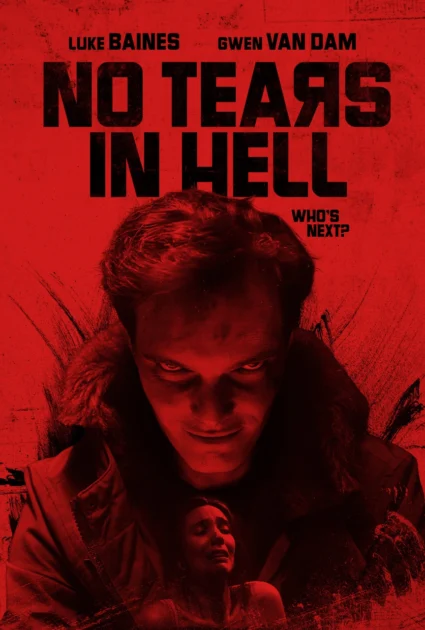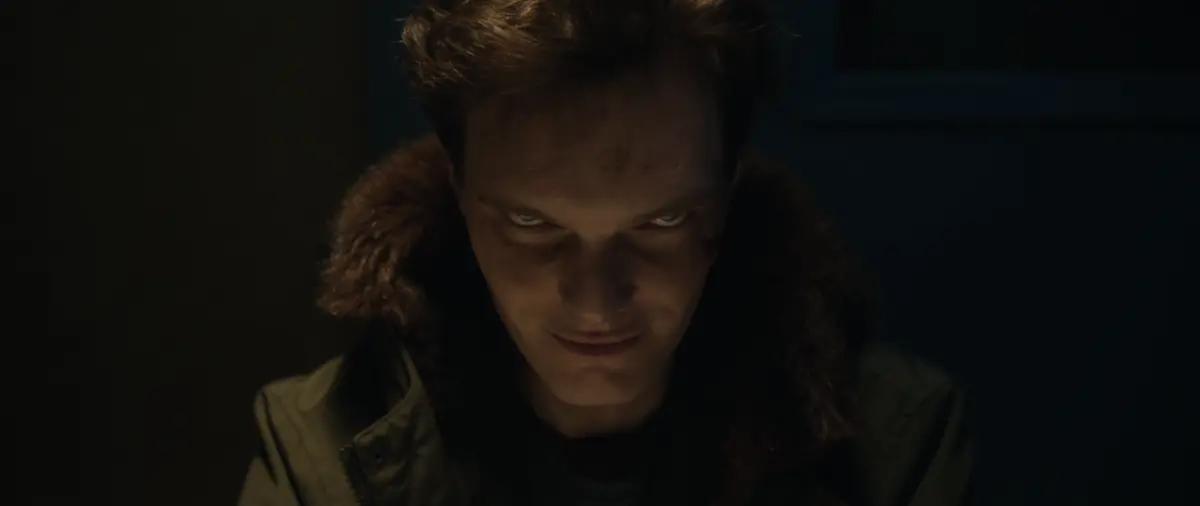Mummy Knows Best: The Vile Hunger at the Heart of No Tears in Hell
“No Tears in Hell” review: Michael Caissie’s unflinching true crime horror film starring Luke Baines explores the disturbing case of the Siberian Ripper and his enabling mother. With graphic violence and powerful performances, this unforgettable horror film, based on real events released on August 12, 2025.

No Tears In Hell | Scatena & Rosner Films | Release Date: August 12 (Digital & VOD)
Written & Directed by: Michael Caissie
Starring: Luke Baines, Gwen Van Dam, Tatjana Marjanovic, Audrey Neal, Gabriella Westwood, Erik Fellows
Distribution: Scatena & Rosner Films
Review by: Mother of Movies
No Tears in Hell Review: A Descent Into True Horror’s Most Disturbing Depths
This review discusses a film containing extreme graphic violence, sexual assault, cannibalism, and disturbing themes based on real events. The film portrays brutality that some viewers may find deeply upsetting. Reader discretion is strongly advised.
The Siberian Ripper Reimagined
When cinema ventures into the darkest corners of humanity, it often tiptoes around the truly horrifying. “No Tears in Hell” does no such thing. Director Michael Caissie’s unflinching portrayal of Alexander Spesivtsev’s crimes strips away Hollywood’s typical serial killer glamorization, replacing it with something far more unsettling: brutal realism.
Set against Alaska’s unforgiving winter landscape (though the real crimes occurred in Siberia), the film introduces us to Alex (Luke Baines) and his mother (the late Gwen Van Dam) as they transform their apartment into a house of horrors. The film begins with deceptive restraint, a voiceover discussing poverty and handwriting experts, punctuated with subtle quips that initially seem disconnected. This calculated approach makes what follows all the more jarring.
The Mother-Son Dynamic in “No Tears in Hell”
The film’s most disturbing element isn’t necessarily the graphic violence, though there’s plenty, but the twisted relationship between Alex and his mother. Van Dam’s performance walks a precarious line between maternal devotion and monstrous enablement. When we witness her showing young Alex crime scene photos after he’s beaten up at school, the nature-versus-nurture question rises to the surface. This moment serves as a grotesque origin story, explaining without excusing the horror that follows.
“You gotta eat,”
Quote from the true story based horror film, No Tears in Hell
She tells her son with disturbing tenderness after another kill, normalizing the unthinkable. It’s in these quiet moments between bloodshed that “No Tears in Hell” finds its most chilling notes.
Beyond Exploitation: When True Crime Meets Horror
Caissie’s direction initially suggests restraint, with early kills happening off-screen. This proves to be a calculated misdirection. As Alex’s depravity escalates to include necrophilia and cannibalism, the camera becomes increasingly unflinching. The film doesn’t shy away from showing Alex’s methodical approach to his victims, particularly disturbing when he forces one captive to harm another.
“I’m doing this for many reasons,”
Alex tells his victims,
“But mostly because I can.”
This line encapsulates the film’s approach to its subject matter, presenting evil not as something supernatural or even particularly complex, but as the simple result of unchecked human depravity paired with opportunity.
The cinematography employs a cold palette of blues and grays that feels appropriately clinical, and at times, the visual style feels stylistic. The sound design, however, deserves particular praise; the squelching, cutting, and tearing sounds do much of the heavy lifting during the most graphic scenes, allowing our imagination to fill in gaps more terrifying than any visual could provide.
When Performance Transcends Horror
Luke Baines deserves recognition for his commitment to this deeply uncomfortable role. His Alex appears outwardly normal, like anyone’s brother or mate at the pub, with the timbre of a radio host. In the opening scenes, he reminded me of a young Dexter, complete with an inner voice monologue and a sly smile, making his actions all the more disturbing. Baines navigates the character’s twisted psychology without resorting to the typical serial killer tropes or theatrical menace.
The film’s exploration of Alex’s institutionalization and sexual trauma provides context without sympathy. These scenes are handled with a matter-of-factness that refuses to romanticize trauma as an excuse for monstrosity, a refreshing approach in a genre that often leans on childhood damage as shorthand for adult violence.
The supporting cast, particularly the victims, brings a painful humanity to their roles. Their terror feels authentic rather than performative, creating moments where I had to look away from the screen, not because of the gore, but because of the raw emotional distress on display.

Fact Versus Fiction: The Real Siberian Ripper
While “No Tears in Hell” claims to be based on Alexander Spesivtsev’s crimes, the film takes significant creative liberties. The real Spesivtsev operated in Novokuznetsk, Russia, during the 1990s, not in Alaska. He was indeed assisted by his mother, Lyudmila, who helped lure victims to their apartment.
The real case involved primarily young women and children as victims, with estimates of his murder count ranging from 19 to potentially 80+ victims. Like in the film, Spesivtsev did engage in cannibalism, though some details are dramatized for the screen.
Perhaps the most accurate aspect is the mother-son dynamic; Spesivtsev’s mother was indeed complicit, helping to dispose of bodies and clean up crime scenes. She was sentenced to 13 years for her role, while Alexander was declared insane and committed to a psychiatric hospital, where he reportedly remains today.
The film’s portrayal of his fascination with Jeffrey Dahmer appears to be a fictional embellishment, as is the subplot involving the homeless camp and police investigation. These creative choices serve the narrative but diverge from the historical record.
Verdict
“No Tears in Hell” is a film that will divide audiences, not on its technical merits, but on whether such unflinching depictions of real-life horror serve a purpose beyond exploitation. For those who can stomach its brutality, it offers a rare glimpse into the banality of evil, the mundane conversations over dinner while victims suffer nearby, the mother-son relationship that nurtures monstrosity instead of humanity.
“No Tears in Hell” is rated
3.5 Monsters Made, Not Born out of 5
Cast: Luke Baines, Gwen Van Dam, Tatjana Marjanovic, Audrey Neal, Gabriella Westwood, Erik Fellows Director: Michael Caissie Writer: Michael Caissie (screenplay), Alexander Nistratov (story) Distribution: Scatena & Rosner Films Release Date: August 12, 2025 | Love the gory depths of serial killers. Get onto these titles next: Artik | The Clovehitch Killer | The Creep Tapes | Pig Killer
A slow-burning, stomach-turning dive into real-life horror, No Tears in Hell disturbs with quiet intensity and full-throttle depravity. A brutal, unforgettable ride.
